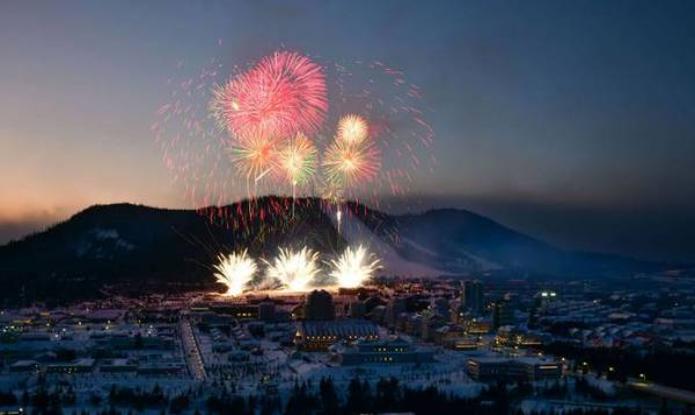| Baekdu-san used as Symbols the sacred "White-Head Mountain" of the North used as a symbol of Korea's national aspirations (sometimes together with Jeju-do's Halla-san) |
Baekdu-san has been important to Korea's sense of identity and prosperity in most eras of
its history, from the Goguryeo Kingdom thru the unified dynasties until today.
From the Goryeo Dynasty histories:
When the mystical Buddhist/Daoist monk Myocheong raised a significant rebellion around 1130
(mostly based on his advocacy of moving the capital northwards to achieve a superior position according
to his Pungsu-jiri readings) and had a new palace built in Pyeongyang, some Confucian scholars
supporting him approved of his constructing eight shrines for nation-protecting/benefiting "Immortals",
and advocated that the Spirits of Baekdu-san, Taebaek-san and Jiri-san be the first ones enshrined.
its history, from the Goguryeo Kingdom thru the unified dynasties until today.
From the Goryeo Dynasty histories:
When the mystical Buddhist/Daoist monk Myocheong raised a significant rebellion around 1130
(mostly based on his advocacy of moving the capital northwards to achieve a superior position according
to his Pungsu-jiri readings) and had a new palace built in Pyeongyang, some Confucian scholars
supporting him approved of his constructing eight shrines for nation-protecting/benefiting "Immortals",
and advocated that the Spirits of Baekdu-san, Taebaek-san and Jiri-san be the first ones enshrined.
Baekdu-san is sometimes paired with Halla-san
on Jeju-do Island as an eum-yang (yin-yang) dyad
(sometimes with a male-female-couple motif implied)
representing Korean aspirations for national
re-unification, due to their coincidental status as
the nothernmost and southernmost of the country's
mountains (both are among the most-sacred mountains
of the entire nation), and that they are both extinct
volcanoes (the only ones in Korea, along with
Ulleung-do Island) -- both with lakes in their
summit-craters (although the Baekrok-dam [White-
Deer Pond] atop Halla is tiny compared to Cheonji-ho).
The fact that Baekdu-san and Baekrok-dam both
begin with the character "Baek" (the sacred color White)
is also sometimes used for meaningful parallelism.
on Jeju-do Island as an eum-yang (yin-yang) dyad
(sometimes with a male-female-couple motif implied)
representing Korean aspirations for national
re-unification, due to their coincidental status as
the nothernmost and southernmost of the country's
mountains (both are among the most-sacred mountains
of the entire nation), and that they are both extinct
volcanoes (the only ones in Korea, along with
Ulleung-do Island) -- both with lakes in their
summit-craters (although the Baekrok-dam [White-
Deer Pond] atop Halla is tiny compared to Cheonji-ho).
The fact that Baekdu-san and Baekrok-dam both
begin with the character "Baek" (the sacred color White)
is also sometimes used for meaningful parallelism.
Baekdu-san is regarded as the holiest of mountains to most Koreans,
due to its being the highest peaks on the peninsula, its location at the head
of the Baekdu-daegan Mountain-System and its remakable topography --
particularly the "Cheonji-ho" [Heaven-Earth Lake] in its summit-crater.
Therefore images of that lake surrounded by a circle of peaks are frequently
used as symbols of Korea's national aspirations -- especially re-unification,
but also national independence, prosperity, unique identity, strength / power,
and so on. This iconic trend started in the early 20th Century and grows ever
more pervasive -- it is rare to find a government or commercial building that
does not have a portrait of the peak of this mighty summit hanging in it!
Here, it is carved in stone as background to the main statue (of age-
old Korean dedication to national sovereignty) at the country's primary
Independence Hall in Cheonan City, South Chungcheong Province.
due to its being the highest peaks on the peninsula, its location at the head
of the Baekdu-daegan Mountain-System and its remakable topography --
particularly the "Cheonji-ho" [Heaven-Earth Lake] in its summit-crater.
Therefore images of that lake surrounded by a circle of peaks are frequently
used as symbols of Korea's national aspirations -- especially re-unification,
but also national independence, prosperity, unique identity, strength / power,
and so on. This iconic trend started in the early 20th Century and grows ever
more pervasive -- it is rare to find a government or commercial building that
does not have a portrait of the peak of this mighty summit hanging in it!
Here, it is carved in stone as background to the main statue (of age-
old Korean dedication to national sovereignty) at the country's primary
Independence Hall in Cheonan City, South Chungcheong Province.

Also there in the Independence Hall, in
its display of Korea's early history, a
typical photograph of Baekdu-san
Cheonji-ho is used as backdrop for a
reproduction of the gigantic stone stele
of Great King Gwanggaeto even though
its site (in Manchuria, marking the extent of
his Goguryeo Kingdom and proclaiming the
virtues of his rule, which was 391-413 CE)
is not very close to this mountain.
its display of Korea's early history, a
typical photograph of Baekdu-san
Cheonji-ho is used as backdrop for a
reproduction of the gigantic stone stele
of Great King Gwanggaeto even though
its site (in Manchuria, marking the extent of
his Goguryeo Kingdom and proclaiming the
virtues of his rule, which was 391-413 CE)
is not very close to this mountain.
An echo of ancient Korean San-shin and Heaven-
worshipping ceremonies, from the Korea Herald in
September 2002. The women above are dressed as
"Bi-seon" [flying immortals, or Angels], aka "Seon-nyeo"
[immortal girls], which frequently appear in San-shin
paintings, folk-tales and Buddhist art (see pages 81-91
in my book). This is a good example of Halla-san and
Baekdu-san being paired in reunification-oriented ritual,
art and event-rhetoric in modern Korea.
Left: Paired girl-boy torch-bearers named after these
two mountains enter the Asian Games Stadium in
Busan City. "Baek" [white] is actually a family name in
Korea, so their "names" (see caption) don't seem too
strange... It's always good to see this kind of continuity
of sacred-mountain traditions, used in modern social
and political events...
worshipping ceremonies, from the Korea Herald in
September 2002. The women above are dressed as
"Bi-seon" [flying immortals, or Angels], aka "Seon-nyeo"
[immortal girls], which frequently appear in San-shin
paintings, folk-tales and Buddhist art (see pages 81-91
in my book). This is a good example of Halla-san and
Baekdu-san being paired in reunification-oriented ritual,
art and event-rhetoric in modern Korea.
Left: Paired girl-boy torch-bearers named after these
two mountains enter the Asian Games Stadium in
Busan City. "Baek" [white] is actually a family name in
Korea, so their "names" (see caption) don't seem too
strange... It's always good to see this kind of continuity
of sacred-mountain traditions, used in modern social
and political events...

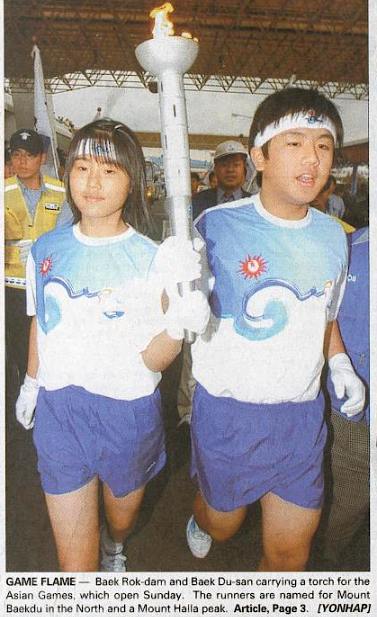


Baekdu-san is also very frequently used in the official
iconography of North Korea. In Pyeongyang City, capital of
the DPRK, it is the background for the gargantuan bronze
statue of "Great Leader and Eternal President" Kim Il-sung.
iconography of North Korea. In Pyeongyang City, capital of
the DPRK, it is the background for the gargantuan bronze
statue of "Great Leader and Eternal President" Kim Il-sung.
The Korea Herald newspaper, on July 1st 2005:

| Kim Il-sung and his son Kim Jong-il on the peak of Baekdu-san in an idealized inspirational-propaganda painting entitled "The Way Forward". |
Of course, the main usage of Baekdu-san as
a nationalist symbol in South Korea is as the
"Taebaek-san" of the Gaecheon-jeol Myth, as the
birthplace of its Founding-King Dan-gun Wanggeom.
a nationalist symbol in South Korea is as the
"Taebaek-san" of the Gaecheon-jeol Myth, as the
birthplace of its Founding-King Dan-gun Wanggeom.

North Korean 2000 won bills depict the "secret camp" beneath "Jongil-bong" Peak (upper left) where, according to their
propaganda myth, "Dear Leader" Kim Jong-il was born during his father's guerrilla-war against the Japanese colonialists,
and a view of Baekdu-san itself (right). The 1000 won bills below depict Kim Il-sung's birthplace in Pyeongyang, in parallel.
propaganda myth, "Dear Leader" Kim Jong-il was born during his father's guerrilla-war against the Japanese colonialists,
and a view of Baekdu-san itself (right). The 1000 won bills below depict Kim Il-sung's birthplace in Pyeongyang, in parallel.

| it is also a popular nationalistic subject for painters traditional & modern, south & north. This is "Lake of Mt. Baekdu" by Bang In-su, 2008. |

| "Mt. Baekdu in June" by Kim Myong-un, 2006 |
| door at the Inwang-sa shaman-complex in Seoul |
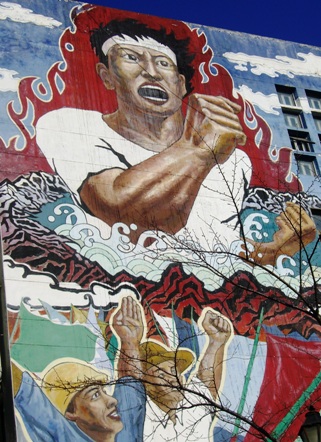
In a revolutionary-leftist mural from the
1986-1992 political turbulence, still
seen on Kyung Hee University's Student
Union Building, the enraged male
activist-student is depicted as rising
up out of Baekdu-san's crater-lake.
1986-1992 political turbulence, still
seen on Kyung Hee University's Student
Union Building, the enraged male
activist-student is depicted as rising
up out of Baekdu-san's crater-lake.

| Baekdu-san Whiskey!! bottle generously brought to me by friend & partner Roger Shepherd from his spring 2012 trip to the DPRK. It actually claims to be a blueberry liquor (a brandy?), but there is no fruit taste to it at all. Color is like whiskey. It's certainly not good whiskey or brandy, but it is indeed liquor... maybe the world's least-known brand? |
Announcement from the DPRK official media:
Paektusan General Museum to Be Built
Jul. 10, Juche 101 (2012) Tuesday
The Paektusan (Mt. Paektu) General Museum will be constructed in the Samjiyon district. It will give a wide
range of knowledge as a center for education in the revolutionary traditions comprehensively showing the
revolutionary relics and the grand nature in the area around Mt. Paektu.
The great General Kim Jong Il said that the explorers and visitors should know the immortal revolutionary
exploits of the peerlessly great persons and the lofty love for the fatherland of the anti-Japanese revolutionary
forerunners and everybody, if he or she is Korean, should have knowledge of Mt. Paektu. The visitors will
deeply realize once again the validity of these words through their inspection of the museum.
Officials, researchers and employees of the Central Commanding Office of the Shock Brigade 618, the
Revolutionary Relics Administration Guidance Bureau, various institutes under the State Academy of
Sciences, the History Institute under the Academy of Social Sciences, the Central Information Agency
for Science and Technology, General Exploration Party on Lake Chon on Mt. Paektu, the Paektu Museum
team and many other units are making every sincere effort to build the general museum well.
Correspondent Jon Chol Ju
Paektusan General Museum to Be Built
Jul. 10, Juche 101 (2012) Tuesday
The Paektusan (Mt. Paektu) General Museum will be constructed in the Samjiyon district. It will give a wide
range of knowledge as a center for education in the revolutionary traditions comprehensively showing the
revolutionary relics and the grand nature in the area around Mt. Paektu.
The great General Kim Jong Il said that the explorers and visitors should know the immortal revolutionary
exploits of the peerlessly great persons and the lofty love for the fatherland of the anti-Japanese revolutionary
forerunners and everybody, if he or she is Korean, should have knowledge of Mt. Paektu. The visitors will
deeply realize once again the validity of these words through their inspection of the museum.
Officials, researchers and employees of the Central Commanding Office of the Shock Brigade 618, the
Revolutionary Relics Administration Guidance Bureau, various institutes under the State Academy of
Sciences, the History Institute under the Academy of Social Sciences, the Central Information Agency
for Science and Technology, General Exploration Party on Lake Chon on Mt. Paektu, the Paektu Museum
team and many other units are making every sincere effort to build the general museum well.
Correspondent Jon Chol Ju
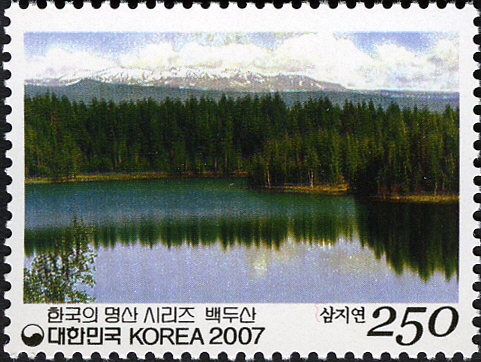
| the famously-lovely Samjiyeon Lake at Baekdu-san's SW foot, on a South Korean stamp |

| Korean Green Tea Master Chae Won-hwa conducting a tea ceremony on the shore of Cheonji Lake at the peak of Baekdu-san in 2005. |
| Wall-painting near Baekdu-san depicting the myth of Kim Jong-il having been born in a cabin at Baekdu-san, a crucial part of NK's leader-family mythology, with a non-Korean couple laying flowers at it while a NK agent films them for propaganda purposes. More on the “Baekdu Bloodline” ideology backing the Pyeongyang leadership, 2014 |

| This shrine was updated in 2013 to include Kim Jong-il who died in December 2011 |


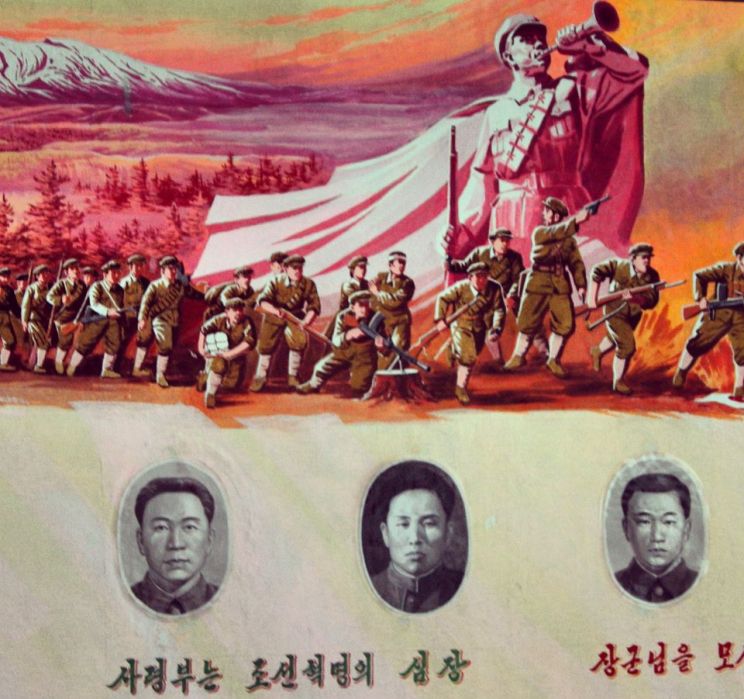
| anti-Japanese communist military heroes "proceeding from Baekdu-san" |


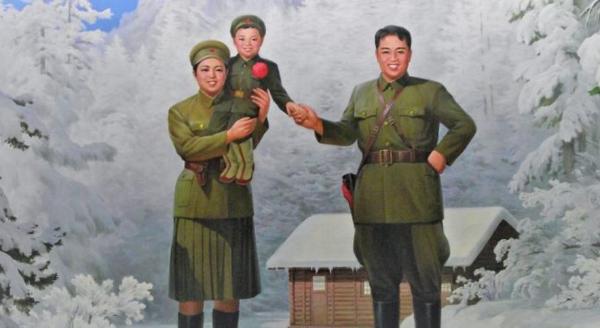

| associated with Founding-King Dan-gun, Hangyeore Magazine 2017 |
Mount Baekdu Bloodline's Influence
Moon and Kim Climb Sacred Mount Baekdu 2018.09
Moon Jae-in Trekking Mount Baekdu with Kim Jong Un
Moon and Kim Climb Sacred Mount Baekdu 2018.09
Moon Jae-in Trekking Mount Baekdu with Kim Jong Un
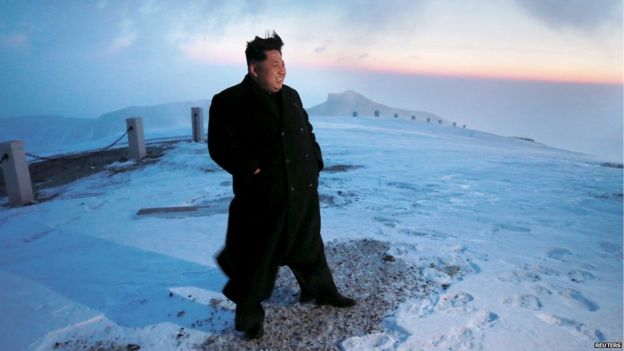
| Kim Jong-un posing at the top of Baekdu-san in late December 2017, just before he made a major speech with a new policy-direction. |


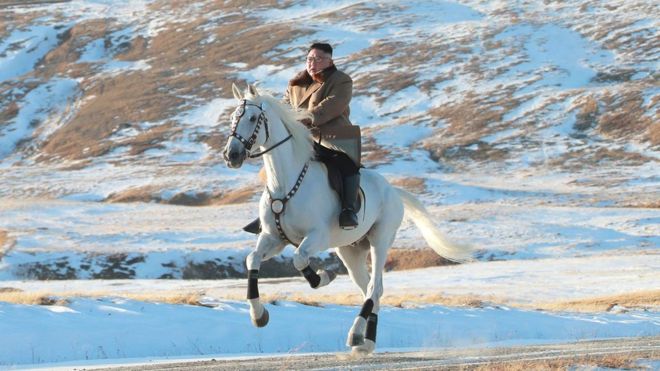
Reported by Laura Bicker of the BBC on October 16th 2009:
North Korean leader Kim Jong-un has climbed the country's highest mountain on horseback, according to state
media. A series of photos released by KCNA show Mr Kim astride a white horse on a snow-covered Mount
Paektu. This is not the first time he has scaled the 2,750-metre peak and analysts say such gestures have been
known to precede major announcements.
The mountain holds a special place in the country's identity and is feted as the birthplace of Kim Jong-un's father.
"His march on horseback in Mt Paektu is a great event of weighty importance in the history of the Korean
revolution," said a KCNA report released on Wednesday. "Sitting on the horseback atop Mt Paektu, [he]
recollected with deep emotion the road of arduous struggle he covered for the great cause of building the most
powerful country, with faith and will as firm as Mt Paektu."
Nothing evokes an image of power quite like a leader astride a white steed, taming the first snows of winter
while galloping through one of the Korean peninsula's most sacred places. This may be an attempt to project
the strength and authority of the "Paektu bloodline" - the Kim family line. A not-so-subtle reminder for the North
Koreans of their leader's power, as well as his prowess on a horse.
But there are a few quotes in the soaring state media prose that should give us pause for thought. The last line in
particular is striking. We are told that the officials with Mr Kim were convinced "there will be a great operation to
strike the world with wonder". Kim Jong-un's previous visits to Mount Paektu have come ahead of major decisions.
North Korean leader Kim Jong-un has climbed the country's highest mountain on horseback, according to state
media. A series of photos released by KCNA show Mr Kim astride a white horse on a snow-covered Mount
Paektu. This is not the first time he has scaled the 2,750-metre peak and analysts say such gestures have been
known to precede major announcements.
The mountain holds a special place in the country's identity and is feted as the birthplace of Kim Jong-un's father.
"His march on horseback in Mt Paektu is a great event of weighty importance in the history of the Korean
revolution," said a KCNA report released on Wednesday. "Sitting on the horseback atop Mt Paektu, [he]
recollected with deep emotion the road of arduous struggle he covered for the great cause of building the most
powerful country, with faith and will as firm as Mt Paektu."
Nothing evokes an image of power quite like a leader astride a white steed, taming the first snows of winter
while galloping through one of the Korean peninsula's most sacred places. This may be an attempt to project
the strength and authority of the "Paektu bloodline" - the Kim family line. A not-so-subtle reminder for the North
Koreans of their leader's power, as well as his prowess on a horse.
But there are a few quotes in the soaring state media prose that should give us pause for thought. The last line in
particular is striking. We are told that the officials with Mr Kim were convinced "there will be a great operation to
strike the world with wonder". Kim Jong-un's previous visits to Mount Paektu have come ahead of major decisions.
| Korea's Kim celebrates completion of 'modern mountainous city' "North Korea has celebrated the completion of leader Kim Jong Un's signature construction project, a new city near the sacred mountain where his family claims its roots, with state media on Tuesday calling it the "epitome of modern civilisation". A massive celebration involving fireworks was held at the city near Mount Paektu on Monday, the official KCNA news agency said. Guardian Article |
